| Maintaining the TECH
edge
The development of high-tech products
occurs through a disciplined process that ultimately creates value for
customers and will help Boeing thrive in the future
BY JUNU KIM

For Boeing, there was more to two recent contract wins than just securing
pacts initially worth a total of more than $600 million from the U.S.
Army.
On their face alone, the two wins were great news: first, in March, the
selection of the team of Boeing and Science Applications International
Corporation as the lead systems integrator for the Army's Future Combat
Systems; and then, in June, the selection of Boeing as the prime system
engineering contractor to develop the Army's Joint Tactical Radio System.
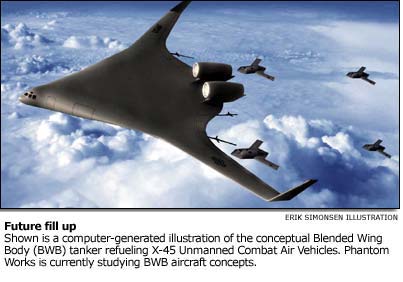 But
their real significance is in what they portend about Boeing's approach
to the future — and about its strategy to pursue integrated, networked,
system-of-system solutions for customers. In the past, the Army has turned
to Boeing primarily for rotorcraft. However, these two contracts pave
the way for Boeing to address a new market worth as much as $200 billion
over the next decade — and that's just in the area of integrated battlespace.
More market areas — some in the military or government arenas and others
in the commercial arena — are open to the same types of solutions involving
communication and information-sharing among various nodes and platforms. But
their real significance is in what they portend about Boeing's approach
to the future — and about its strategy to pursue integrated, networked,
system-of-system solutions for customers. In the past, the Army has turned
to Boeing primarily for rotorcraft. However, these two contracts pave
the way for Boeing to address a new market worth as much as $200 billion
over the next decade — and that's just in the area of integrated battlespace.
More market areas — some in the military or government arenas and others
in the commercial arena — are open to the same types of solutions involving
communication and information-sharing among various nodes and platforms.
Phantom Works, the company's arm for advanced research and development,
and Space and Communications led the FCS and JTRS efforts (more information
about each is available on the Boeing Web at http://www.boeing.com/news/releases/).
Pursuing, winning and executing the FCS and JTRS contracts is part of
Boeing's vision of the integrated battlespace of the future, where networked
information and communications systems give a competitive edge to soldiers
in the field and commanders in the control room. This vision works hand-in-hand
with the Army's goal of transforming itself into a strategically responsive
force that's more agile, sustainable, lethal and survivable.
Company officials see the FCS and JTRS wins as validations of Boeing's
approach to technology development — an approach that involves the prudent
investment in technologies relevant to customers' future needs; the development
and acquisition of technologies useful to multiple business units; the
establishment of partnerships to secure access to existing abilities and
emerging technologies; and the integration of these developments in current
and future products and services.
"Companies that have the capability to do large-scale system-ofsystems
integration and provide the right information management capabilities
are going to be highly advantaged" in contracts related to the U.S. Defense
Department's transformation, said Ron Prosser, vice president, Advanced
Space and Communications, for Phantom Works. The awards of FCS and JTRS
are the best validation that we're on the right track, he said.
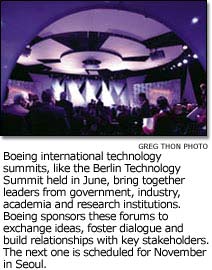 Boeing's
ability to acquire or develop technologies that enhance its products and
services or improve its design and production processes plays an integral
part in the two future-oriented elements of its business strategy — leveraging
its core strengths and opening new frontiers — while maintaining healthy
core businesses. These developments will serve as the foundation of Boeing's
future ability to meet the demands of customers seeking improved solutions
and to address the challenge of intensified competition. Boeing's
ability to acquire or develop technologies that enhance its products and
services or improve its design and production processes plays an integral
part in the two future-oriented elements of its business strategy — leveraging
its core strengths and opening new frontiers — while maintaining healthy
core businesses. These developments will serve as the foundation of Boeing's
future ability to meet the demands of customers seeking improved solutions
and to address the challenge of intensified competition.
"Our business depends on our ability to deliver value to our customer
through great ideas," said Dave Swain, chief technology officer, who as
CTO heads Boeing's Technology organization, which includes Phantom Works.
"Without innovations in technology, there is no growth plan and we will
stagnate quickly. With technology, we have a great future."
Innovative technologies have permitted Boeing to introduce products from
the Model 40A mail and passenger airplane of the 1920s to the Delta family
of rockets. They also have made the work being done on revolutionary ideas
for the future — the Sonic Cruiser commercial airplane, the X-45A
Unmanned Combat Air Vehicle and the X-37 reusable spaceplane — elements
of daily business life today. In other words, thanks to advancements in
technology, the future of Boeing is currently in development.
"Maintaining a technology edge is integral to our existence," said Bill
Lawler, vice president and general manager of Strategic Operations and
Planning for Military Aircraft and Missile Systems. As an aerospace company,
Boeing's products "are all high-tech products. We compete in a world where
Boeing is defined by its technological edge."
Formula for innovation
In the eyes of Boeing senior technology executives, the formula for innovation
requires three basic ingredients:
- People. The genesis of technology is, and always will be, a human's
idea. That's why, in the words of Phantom Works President George Muellner,
"intellectual capital is essential to our future." And to make the most
out of this asset, Boeing seeks to reap the benefits of intellectual
diversity by involving individuals from multiple business units, backgrounds
and cultures on its projects.
- An environment for innovation. Better ideas emerge not merely from
empirical observations but from an atmosphere where creativity, diverse
ways of thinking and risk-taking are fostered.
- An ability to execute research and development programs efficiently.
Leveraging R&D investment
In a business setting, technology creation also requires funding. Typically,
Boeing earmarks between 3 and 3.5 percent of its annual revenues to R&D
activities.
Business units apply most of the Boeing-invested funds to solutions specific
to their businesses. Phantom Works' investments are used to develop common
technologies — the "technology thrusts" that have applications to
products and services in multiple business units. A portion of Phantom
Works' R&D funds is devoted to "enabling technologies" — future technologies
that could have major effects on Boeing future products and services.
Phantom Works also captures government contract technology funds (CRAD)
to augment the company's technology investment. This CRAD and the contributions
from suppliers and partners produces a leverage of almost five to one
for Boeing's investment dollars.
What common technology development efforts get funded are based on an
annual, disciplined process coordinated by Phantom Works. This procedure
begins by Phantom Works' Technology Planning and Acquisition organization
working with the business units to determine what capabilities are needed.
Customer needs drive Boeing solutions
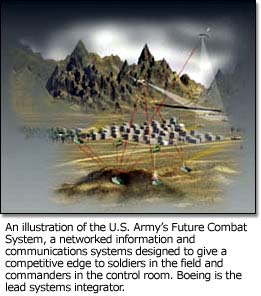 These
objectives are based on input of the business units' customers, to assure
that technology investments ultimately deliver value. "You first have
to answer the question, what does the market need, and what do your customers
need to provide for their marketplaces? Once your customers have helped
you define these needs, you look to technology to ‘enable' those products,"
said Frank Statkus, vice president-advanced technology for Commercial
Airplanes and head of Advanced Commercial Airplanes for Phantom Works. These
objectives are based on input of the business units' customers, to assure
that technology investments ultimately deliver value. "You first have
to answer the question, what does the market need, and what do your customers
need to provide for their marketplaces? Once your customers have helped
you define these needs, you look to technology to ‘enable' those products,"
said Frank Statkus, vice president-advanced technology for Commercial
Airplanes and head of Advanced Commercial Airplanes for Phantom Works.
Some business units face the challenge of integrating the opinions of
an extremely diverse customer base. As part of its efforts in developing
and implementing a next-generation air traffic control system, Air Traffic
Management convened a Working Together team that involved 39 disparate
stakeholders in the air traffic management arena, from the U.S. Federal
Aviation Administration to airlines to the U.S. Department of Defense.
"Our system-of-systems is not only about information, hardware and software,
but also about the people that operate in it," said Dennis Muilenburg,
ATM's vice president, engineering. "Our team needs to not only understand
technology, but also the business, cultural and political angles behind
the implementation of that technology."
As Technology Planning and Acquisition coordinates the business unit
requirements, it looks for the technology programs that can meet multiple
business needs. Examples of these needs include lighter-weight structures
or open systems architecture. "As an enterprise, we want to identify areas
where we can deploy technologies that serve common interests among business
units," said Craig McElfresh, senior manager in Technology Planning and
Acquisition.
After Technology Planning and Acquisition identifies what capabilities
are being sought, Boeing's senior technology executives allocate resources
based on the value of the technology — that is, how much more in revenues,
cost savings or profits this innovation might generate — and on the ability
of multiple business units to transition this technology.
Teaming for mutual advantage
Funding decisions are made based upon the best approach for securing
this technology. Chances are that the knowledge may exist — possibly within
Boeing, but maybe also in the outside world, as scientific discoveries
continue to augment the collective compendium of technology knowledge.
To fully leverage the vast resources of the global technology research
community — and provide Boeing with access to developments that could improve
its products or help open markets to it — Boeing has struck partnerships
worldwide with universities, government agencies, companies both within
and outside the aerospace industries, and even suppliers.
For example, to facilitate and coordinate research overseas, Boeing is
establishing research and technology centers abroad; the first one, in
Madrid, Spain, will celebrate its grand opening July 9. Boeing also makes
investments in venture capital firms to gain insight into emerging technologies.
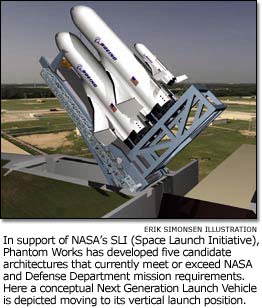 In
the case of FCS, Boeing is teamed with Science Applications International
Corp., an internationally respected, San Diego-based research and engineering
firm that has experience in providing information technology and systems
integration solutions. In
the case of FCS, Boeing is teamed with Science Applications International
Corp., an internationally respected, San Diego-based research and engineering
firm that has experience in providing information technology and systems
integration solutions.
This partnership and investment strategy saves Boeing from spending money
on reinventing the wheel. "It's not physically possible for Boeing to
have on hand all the people who can work on the myriad of ideas available,"
said Bob Spitzer, vice president, External Affiliations for the Technology
organization. "The bandwidth has gone up so much in our business that
we have to be looking outside."
Boeing's partnerships also augment the company's technology budget. The
intellectual capital gained through dealings with people outside is an
amplification of Boeing's technology investment, particularly since the
investment is done through other sources of funds such as suppliers, government
agencies and laboratories or the Department of Defense.
Finally, the development of common and enabling technologies, which is
handled by Phantom Works, is managed with the same rigorous discipline
as any other program within the company. That includes forming an organization;
setting objectives, milestones and review mechanisms; and providing continual
evaluation of the program's progress, relevance and viability. The implication
is clear: Boeing develops technology only through a disciplined process,
and the team undertaking the work is accountable for its activities.
The paths of technology
To create value from these developments, the Technology organization
follows one of four paths:
- Transitioning technology, or moving developments
into business unit products and services. Among the recent transitions
is the implementation of knowledge gained in the design and manufacturing
of the Joint Strike Fighter prototypes. These lessons have been incorporated
into the redesign of the forward fuselage of the F/A-18 E/F Super Hornet,
which has led to the creation of a more affordable, higher quality structure.
"JSF was a proving ground for many advanced technologies that previously
had never been fully applied to a real project," said Mike Heinz, vice
president and general manager of Unmanned Systems at Military Aircraft
and Missiles Systems and formerly the vice president and deputy program
manager of Boeing's Joint Strike Fighter development efforts.
- Inventing new advanced concepts.
These projects include the X-45A Unmanned Combat Air Vehicle and the
X-50A Canard Rotor/Wing aircraft. The X-50A is intended to combine the
hovering and low-speed flight characteristics of a helicopter with the
high cruise speed of a fixed-wing aircraft. One possible application
of this aircraft could be search-and-rescue operations, said J.B. Peterson,
vice president and general manager for Advanced Military Aircraft and
Missiles, Phantom Works.
- Licensing intellectual property.
By allowing other firms to license a proprietary development, Boeing
can generate additional economic profit from its achievements. "Customers
value what you've done technologically when they buy your product. But
another indicator of your technological strength is if someone else
wants to license it," said Gene Partlow, vice president, Intellectual
Property Business.
- Using the Chairman's Innovation Initiative.
The CII is a program to create new businesses based on business-building
concepts from employees. "By providing an opportunity for employees
to generate, develop and implement new businesses, we help nurture an
innovative and entrepreneurial environment so important to our future
growth," said Anil Shrikhande, vice president, Boeing Ventures.
Better vs. best?
The constant advancements brought on by technology raise the question:
What challenges await Boeing's efforts to maintain its status as an aerospace
leader?
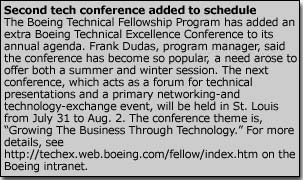 Undoubtedly,
one major challenge will be competition. Customers may opt for products
and services other than the best that Boeing and its technology minds
can provide. As Jerry Daniels, Military Aircraft and Missile Systems'
president and CEO, wrote in a message in October 2001 after being debriefed
by the Department of Defense on its Joint Strike Fighter decision: "Our
‘A' was not as good as Lockheed Martin's ‘A-plus.'" Undoubtedly,
one major challenge will be competition. Customers may opt for products
and services other than the best that Boeing and its technology minds
can provide. As Jerry Daniels, Military Aircraft and Missile Systems'
president and CEO, wrote in a message in October 2001 after being debriefed
by the Department of Defense on its Joint Strike Fighter decision: "Our
‘A' was not as good as Lockheed Martin's ‘A-plus.'"
"You have to be more and more competitive. You can't keep looking at
the same airplanes coming down the assembly line if they're not showing
improvements," said Statkus.
Keys to future success
Yet another challenge is the ability of Boeing and its people to keep
up with the rapidly evolving technology world. In other words, Boeing
and its employees must:
- Be aware of what's going on. "People
need to keep on top of the emerging technologies that are developing
outside of Boeing," said Bob Krieger, vice president-general manager,
engineering, for Military Aircraft and Missile Systems. Those developments
can come from the private sector or from government entities and universities.
To help Boeing monitor developments in the technical world, the company
supports its Technical Fellows program, which features more than 1,800
Fellows who are strong technically in their field and who have demonstrated
that their work has produced value for Boeing.
- Be open minded. "We have to be
good prospectors in looking for technologies, and we have to be open
minded," Swain said. "For any large company, it's often difficult to
look outside yourself." That's another benefit of partnerships, in Spitzer's
opinion: "Partnerships expose you to a diversity of thought you might
never have had by dealing with your kinfolk. That can be stimulating."
- Adjust to the marketplace. As Boeing
expands beyond its traditional markets of aircraft design, manufacturing
and service, employees must adjust to the ways of life in these new
marketplaces. Case in point: Connexion By Boeing. Because Connexion's
marketplace features products and services with shorter lifecycles and
faster development processes than Boeing's historical markets, the business
unit sought individuals who had experience in industries where accelerated
product development is the norm, such as the communications business.
A brainstorming session looking for ways to illustrate the capabilities
that Connexion's focus on broadband in-flight connectivity makes possible
produced the idea of conducting a real-time aircraft-to-ground broadband
videoconference — which could be useful for operators of executive
jets but had never been done before. The question then became, how quickly
could this be done? The answer, as deduced by Connexion's tech team:
Instead of trying to create the appropriate software, use an off-the-shelf
software program. As a result, it took a mere six weeks to set up a
videoconference demonstration for an internal audience of Boeing executives,
and three months to make the system ready for public presentation. This
videoconferencing technique was publicly introduced at the Boeing Investors
Conference in May, as Connexion President Scott Carson, among the event's
participants in St. Louis, videoconferenced with System Development
Director Ed Laase, aboard the Connexion One airplane above Arizona.
"The integration of this team is a significant opportunity and challenge
for us. But when you do it right, the inventiveness is an incredible
thing to watch," Carson said.
- Understand the nature of future products.
Just how exactly will tomorrow's products be better than today's? Phantom
Works foresees that the aerospace products of the future will share
these characteristics:
- Be highly integrated. The products of tomorrow "are going
to have to be multifunctional and ‘smart,'" Krieger said. "They'll
have to do more than carry loads."
- Adapt to change. A critical factor in Boeing securing the
U.S. Air Force's C-130 Avionics Modernization Program contract was
the application of open-system architecture technology. This approach
to developing avionics systems permits "plug and play" feasibility
and low-cost avionics upgrades. Indeed, Boeing showed it could save
substantial cost over the lifecycle of this multiyear program, worth
approximately $4 billion.
- Provide breakthrough performance.
- Be extremely affordable.
- Be universally friendly. Tomorrow's products will have
to be environmentally friendly — not only as they're produced and
operated, but also after their lifecycles are completed, Krieger
said.
- Be superintelligent.
- Be network-centric. They'll need to interface effectively
and easily with other objects that receive and transmit information.
Indeed, the integration of information technology and communications
technology in network-centric solutions could be "the single most
important (technology) trend in the future," Muellner said.
Ultimately, it would make sense that meeting the challenges to Boeing's
status as a technology leader will revolve heavily around the collective
abilities of its employees. After all, innovations historically have come
from the power of the human brain.
"Although we have a structure that allows us to effficiently develop
technology, what really makes this structure work are the people whose
intelligence, discipline and ingenuity help turn these ideas into reality,"
Swain said.
Additional reporting by William Cole and Daryl Stephenson
|